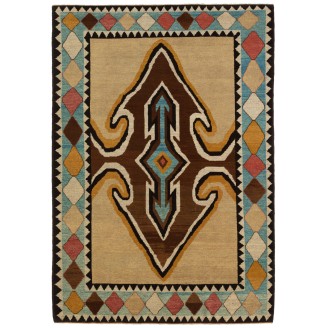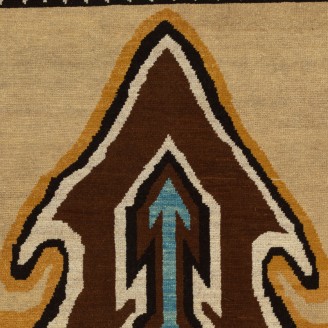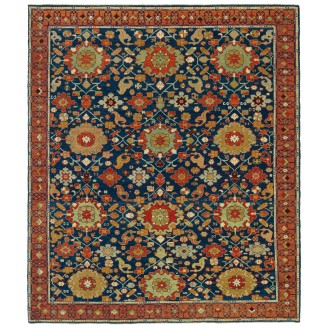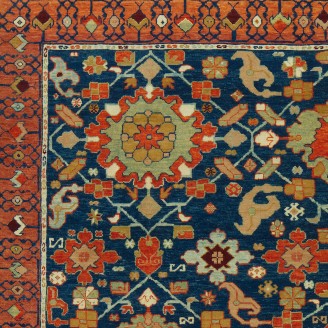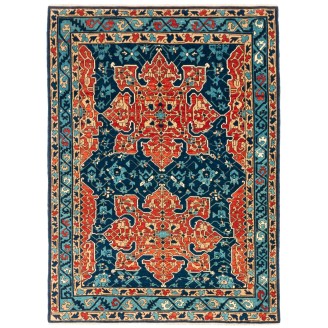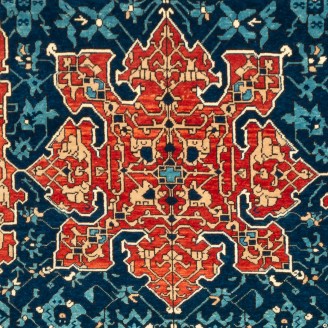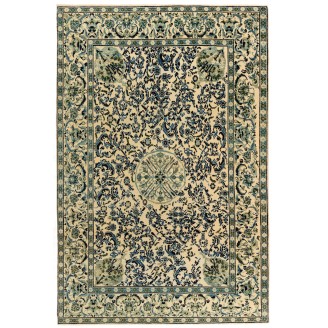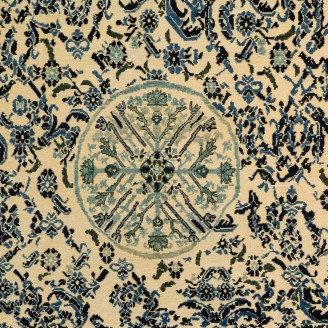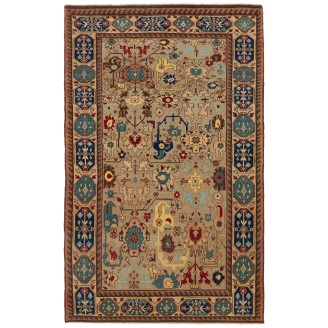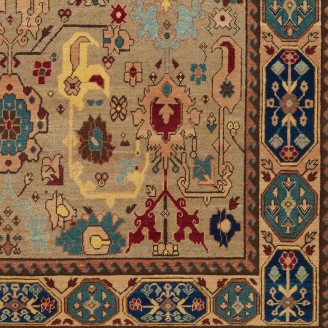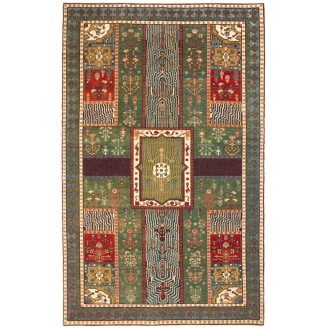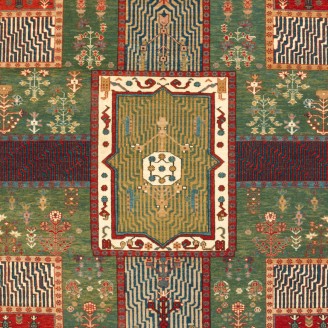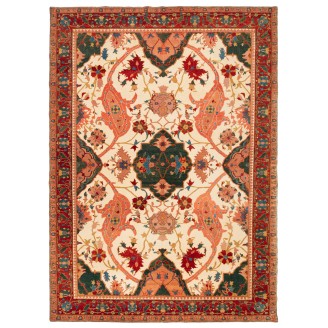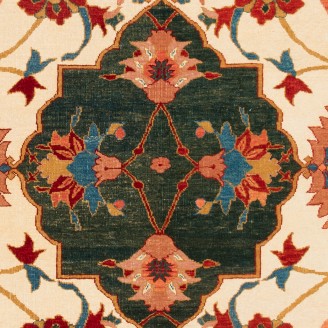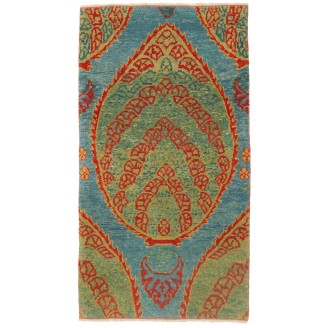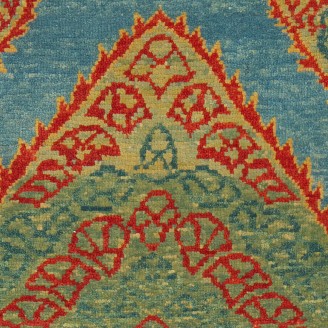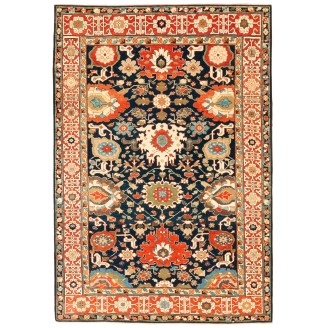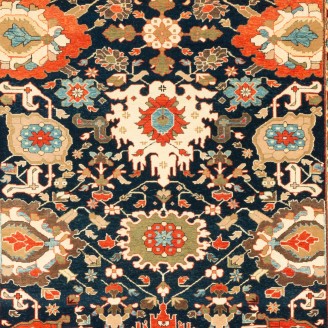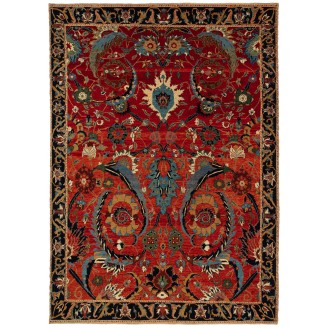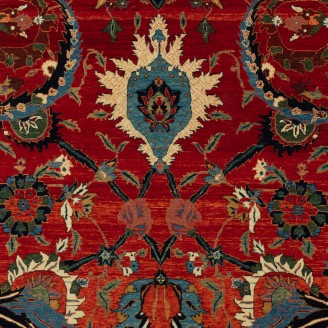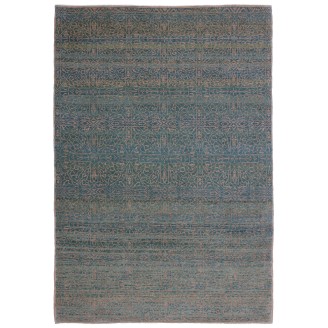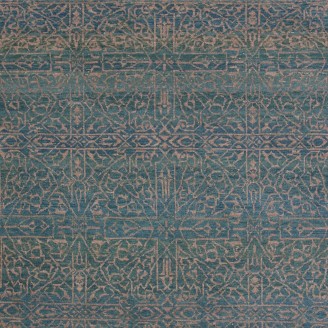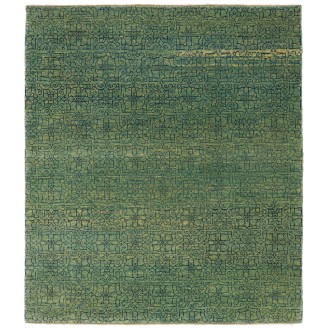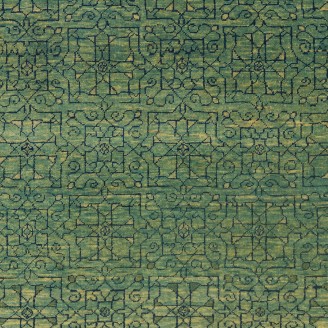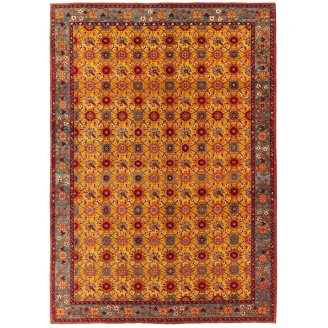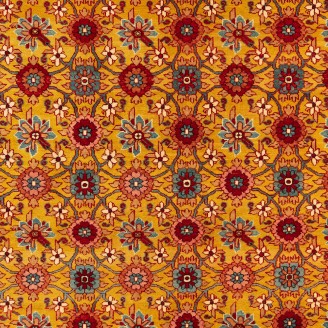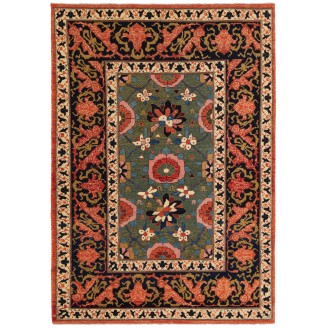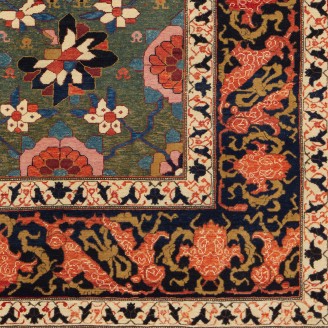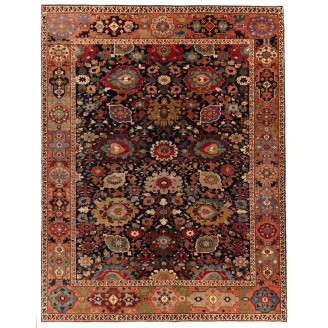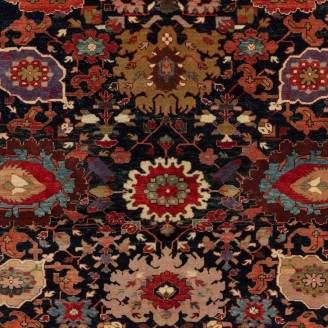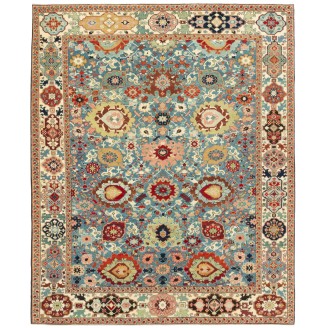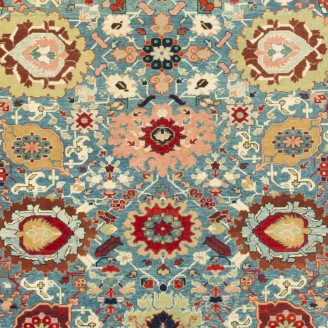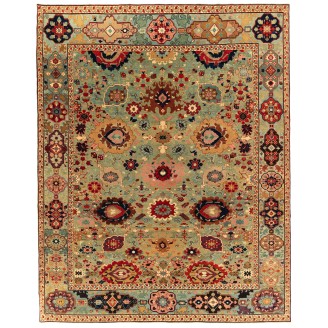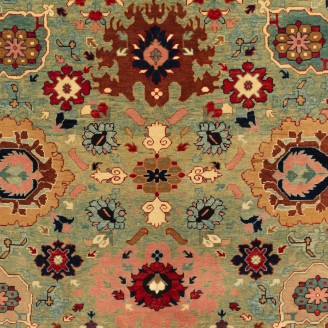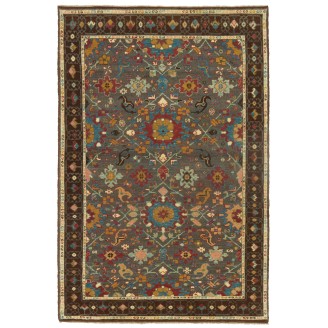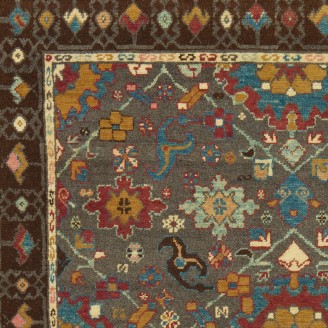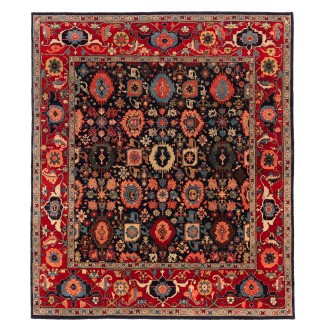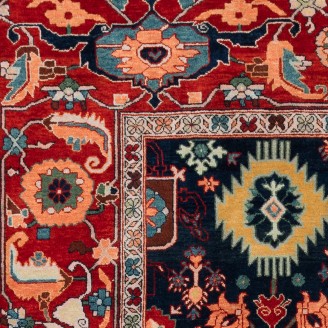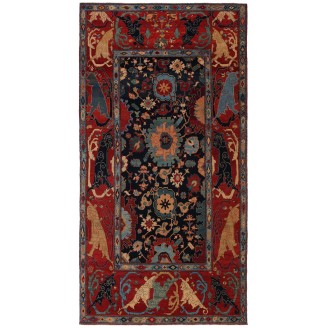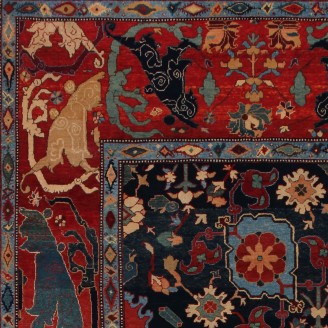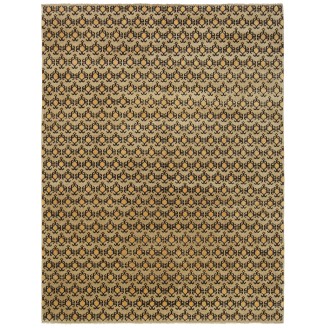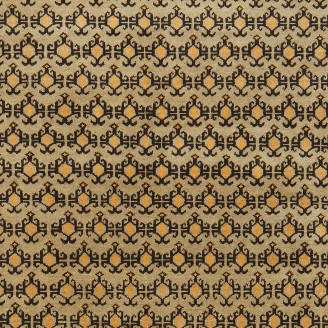Model: ART00578
Dimensions: 4'7" X 6'7"(142cm x 201cm)
This Gabbeh rug, designed in the 1930s, is a type of handwoven rug that originated from Iran, specifically from the southwestern region known as Fars. The word "Gabbeh" itself means "raw" or "natural" in Persian, reflecting the simplicity and primitive charm of these rugs. Gabbeh rugs are traditiona..
Price:
$2,860
Ex Tax:$2,860
Model: ART00516
Dimensions: 6'8" X 7'9"(205cm x 238cm)
This offset pattern is composed of palmettes and flowers, one has the impression that it is only part of a larger scheme designed 19th-century rug from the Bidjar region, Eastern Kurdistan area. Very similar palmettes, drawn in a curvilinear manner and combined with identical forked leaves, can be s..
Price:
$9,300
Ex Tax:$9,300
Model: ART00401
Dimensions: 5'5" X 7'4"(166cm x 224cm)
The source of the carpet comes from the book How to Read – Islamic Carpets, Walter B. Denny, The Metropolitan Museum of Art, New York 2014 fig.46-47 and Orientel Rugs, Volume 4 Turkish, Kurt Zipper and Claudia Fritzsche, Antique Collectors' Club, 1989 nr.82. This 16th-century deeply serrated eight-l..
Price:
$4,200
Ex Tax:$4,200
Model: ART00298
Dimensions: 6'0" X 8'11"(185cm x 274cm)
Turkish Court Manufactury Rugs were woven in the Egyptian workshops founded by Ottoman Empire in the 16th century. Those carpets were woven in Egypt, following the paper cartoons probably created in Istanbul and sent to Cairo at that time.The source of carpet comes from the book Seven Hundred of Ori..
Price:
$8,600
Ex Tax:$8,600
Model: ART00330
Dimensions: 4'3" X 6'9"(131cm x 208cm)
The source of the rug comes from the book Antique Rugs of Kurdistan A Historical Legacy of Woven Art, James D. Burns, 2002 nr.40. This offset pattern is composed of palmettes and stems with large forked leaves, one has the impression that it is only part of a larger scheme designed 17th-century rug ..
Price:
$5,300
Ex Tax:$5,300
Model: ART00394
Dimensions: 6'1" X 9'8"(187cm x 297cm)
The source of the rug comes from the book Islamic Carpets, Joseph V. McMullan, Near Eastern Art Research Center Inc., New York 1965 nr.28. This Persian Garden design rug belongs to the second half 18th century from the Persia area. The design of this rug is based on the Formal Persian Garden. There ..
Price:
$12,000
Ex Tax:$12,000
Model: ARTK0002
Dimensions: 7'9" X 10'8"(238cm x 326cm)
This is a with a central medallion carpet design 19th century from Garrus ( Gerous or Garus ) region, Eastern Kurdistan area. Garrus is located in the foothills approaching the flatlands of Persia, Garrus has been a significant Kurdish city since antiquity when it was the capital of Media Minor. Imp..
Price:
$29,000
Ex Tax:$29,000
Model: ART00103
Dimensions: 1'8" X 3'1"(52cm x 95cm)
The most dramatic of the Gerous ( Garrus, Gerus, Garus ) carpets are those with an "asymmetric" design. Only a section of the original is shown, in the same way, many Lotto carpets were woven. It is difficult to guess the size of these carpets from a photo, but here we enter the area of the "Wagireh..
Price:
$850
Ex Tax:$850
Model: ART00269
Dimensions: 5'6" X 7'11"(169cm x 243cm)
The source of the rug comes from the book Orient Star - A Carpet Collection, E. Heinrich Kirchheim, Hali Publications Ltd, 1993 nr.79. This is unusual design 18th or 19th century rug from Khila, Kuba region East Caucasus area. Very similar palmettes, drawn in a curvilinear manner and combined with i..
Price:
$7,600
Ex Tax:$7,600
Model: ART00528
Dimensions: 8'2" X 11'5"(250cm x 350cm)
The source of carpet comes from the book Museo Calouste Gulbenkian, Printed by Gulbenkian Museum Lisbon, in 2015, nr.52. This is a vase-technique carpet design in the 17th century in the Kerman region, of Persia. In the 16th century, in Safavid Persia, medallion rugs were among the most appreciated,..
Price:
$32,000
Ex Tax:$32,000
Model: ART00287
Dimensions: 5'1" X 7'4"(157cm x 224cm)
This rug has an interpreted design composed of a geometric lattice pattern taken from a part of the Mamluk rug, filling the field elegantly, has the impression that it is only part of a larger scheme designed 15th-century rug from the Mamluk era, Cairo region, Eygpt. Mamluk carpets originated in a p..
Price:
$6,100
Ex Tax:$6,100
Model: ART00527
Dimensions: 4'9" X 5'5"(146cm x 166cm)
The source of the rug comes from the possession of Endre Unger, which was sold at Sotheby’s in 1992. That rug with the central star was designed in the early 16th-century rug by Mamluk Sultane of Cairo, Egypt. The interpreted design is composed of Jerrehian rug's border motifs lattice, covering the ..
Price:
$3,800
Ex Tax:$3,800
Model: ART00305
Dimensions: 6'7" X 9'3"(202cm x 283cm)
The source of the rug comes from the book Antique Rugs of Kurdistan A Historical Legacy of Woven Art, James D. Burns, 2002 nr.2. This was an exclusive example of a Mina Khani lattice design mid-19th century rug from Koliya'i, Southern Kurdistan area. The mina khani is composed of a series of rows of..
Price:
$16,600
Ex Tax:$16,600
Model: ART00506
Dimensions: 4'11" X 7'0"(152cm x 215cm)
The design source of the rug comes from the book Antique Rugs of Kurdistan A Historical Legacy of Woven Art, James D. Burns, 2002 nr.4. This was an exclusive example of a Mina Khani lattice design mid-19th century rug from Koliya'i, Southern Kurdistan area. The mina khani is composed of a series of ..
Price:
$5,700
Ex Tax:$5,700
Model: ART00310
Dimensions: 7'10" X 10'0"(241cm x 306cm)
The source of the rug comes from the book How to Read - Islamic Carpets, Walter B. Denny, The Metropolitan Museum of Art, New York 2014 fig.82. This was an exclusive example of a palmette lattice design 19th-century rug from Northwestern Persia. The design employs floral, richly complex repeating ar..
Price:
$16,800
Ex Tax:$16,800
Model: ART00353
Dimensions: 8'0" X 9'7"(244cm x 293cm)
The source of the rug comes from the book How to Read - Islamic Carpets, Walter B. Denny, The Metropolitan Museum of Art, New York 2014 fig.82. This was an exclusive example of a palmette lattice design 19th-century rug from Northwestern Persia. The design employs floral, richly complex repeating ar..
Price:
$18,600
Ex Tax:$18,600
Model: ART00320
Dimensions: 7'10" X 9'10"(240cm x 300cm)
The source of the rug comes from the book How to Read - Islamic Carpets, Walter B. Denny, The Metropolitan Museum of Art, New York 2014 fig.82. This was an exclusive example of a palmette lattice design 19th-century rug from Northwestern Persia. The design employs floral, richly complex repeating ar..
Price:
$15,800
Ex Tax:$15,800
Model: ART00529
Dimensions: 3'4" X 5'1"(104cm x 157cm)
This offset pattern is composed of palmettes and flowers, one has the impression that it is only part of a larger scheme designed 19th-century rug from the Bidjar region, Eastern Kurdistan area. Very similar palmettes, drawn in a curvilinear manner and combined with identical forked leaves, can be s..
Price:
$3,200
Ex Tax:$3,200
Model: ARTK0003
Dimensions: 7'11" X 9'4"(242cm x 285cm)
This offset pattern is composed of palmettes and flowers, one has the impression that it is only part of a larger scheme designed for 19th-century rugs from the Bidjar region, Eastern Kurdistan area. Very similar palmettes, drawn in a curvilinear manner and combined with identical forked leaves, can..
Price:
$23,000
Ex Tax:$23,000
Model: ART00017
Dimensions: 5'9" X 11'0"(176cm x 336cm)
This offset pattern is composed of palmettes and flowers, one has the impression that it is only part of a larger scheme designed 19th-century rug from the Bidjar region, Eastern Kurdistan area. Very similar palmettes, drawn in a curvilinear manner and combined with identical forked leaves, can be s..
Price:
$14,000
Ex Tax:$14,000
Model: ART00346
Dimensions: 5'10" X 7'5"(178cm x 228cm)
The source of carpet comes from the book Orient Stars Collection, Anatolian Tribal Rugs 1050-1750, Michael Franses, Hali Publications Ltd, 2021 fig.27. This 13th-century carpet is from probably the Konya region, central Anatolia, circa 1200-1300 (C 1290-1420). It is exhibited at the Museum of Turkis..
Price:
$4,000
Ex Tax:$4,000
